Share this
Singapore dental implant case study: distraction osteogenesis
on June 20, 2016
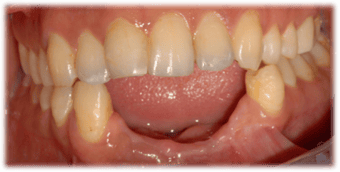 A 30 year old patient male patient lost his lower front teeth due to a motorcycle accident one year ago. The bone supporting the teeth was also destroyed in the process. One year later, he presented for reconstruction of the lost bone and teeth.
A 30 year old patient male patient lost his lower front teeth due to a motorcycle accident one year ago. The bone supporting the teeth was also destroyed in the process. One year later, he presented for reconstruction of the lost bone and teeth.
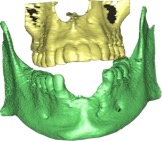 A CT scan showed that there was a significant loss of vertical height of the bone. While there was sufficient bone to place implants to replace the missing teeth, the prosthesis would not be aesthetic. Functionally, there would also be compromises as the gaps between the prosthesis and the gum would trap food and being deep-seated, cleaning would be difficult.
A CT scan showed that there was a significant loss of vertical height of the bone. While there was sufficient bone to place implants to replace the missing teeth, the prosthesis would not be aesthetic. Functionally, there would also be compromises as the gaps between the prosthesis and the gum would trap food and being deep-seated, cleaning would be difficult.
The alternative was to augment the site before placing the implants. The objective was to raise the bone level to the ideal state for implant placement i.e. at the same level of the bone supporting the remaining teeth.
There were two ways of doing this. One way was to harvest a block of bone from the hip and screw it to the deficient part of jaw. After a few months, the bone graft would consolidate and integrate with the jaw bone and implants could be placed. However, the success rate of such vertical bone grafting was low. Furthermore, even if successful, it was difficult to achieve the bone level of the adjacent teeth.
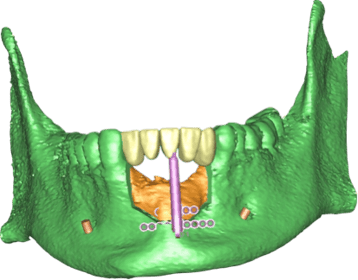
Distraction osteogenesis was chosen instead. This is a process whereby the bone to be augmented is divided and then gradually moved apart on a daily basis. A plan was simulated on a treatment planning software Simplant. In the program, the virtual teeth were placed on the model generated from the CT scan data. The distraction device was also placed on the model and the vector of movement of the segment to be distracted predetermined. Once the position and vector of movement of the device is set, the bone is cut. This segment, however, retained its attachment to the soft tissue which maintained the blood supply.
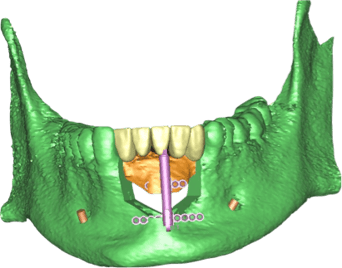 One week after surgery, the device was activated daily for seven consecutive days. Each day, the device moved the segment 1mm higher. This small movement of the segment allowed new bone formation to begin in the gap but before it mineralized, ie “hardened”, the segment was moved again. Over a period of seven days, the bone moved 7mm thereby increasing the height of the bone by that amount.
One week after surgery, the device was activated daily for seven consecutive days. Each day, the device moved the segment 1mm higher. This small movement of the segment allowed new bone formation to begin in the gap but before it mineralized, ie “hardened”, the segment was moved again. Over a period of seven days, the bone moved 7mm thereby increasing the height of the bone by that amount.
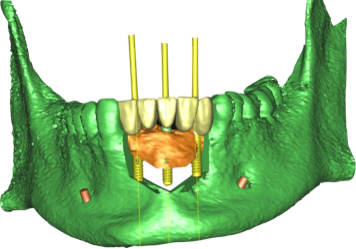 Once the planned amount of distraction was achieved, the distractor was left in place for three months for the bone to consolidate. At the end of three months, the distractor was removed and implants placed. Final restoration of the implants with a fixed dental prosthesis was done two months later.
Once the planned amount of distraction was achieved, the distractor was left in place for three months for the bone to consolidate. At the end of three months, the distractor was removed and implants placed. Final restoration of the implants with a fixed dental prosthesis was done two months later.
Vertical augment of the jaw bone by distraction osteogenesis gives a more stable result than bone grafting because the soft tissue is stretched gradually and the bone that is being moved is not stripped of its blood supply at all times. This combination of maintaining the vitality of the bone and gradual expansion of the soft tissue envelope ensures minimal shrinkage of the bone.
Share this
- Jaw Surgery (93)
- Dental Implants Singapore (90)
- Orthognathic Surgery (48)
- Replacing Missing Teeth (26)
- Missing Teeth Options (23)
- Underbite (23)
- Bone Grafting (21)
- Costs (18)
- Facial Aesthetics (18)
- Aesthetics (17)
- dental implants (16)
- corrective jaw surgery (15)
- BOTOX (11)
- Dermal Fillers (11)
- Wisdom teeth (10)
- Fixed Implant Dentures (8)
- Loose Dentures Singapore (6)
- Medisave (6)
- sleep apnea (6)
- Braces (5)
- Dental Pain (5)
- Dentures in Singapore (5)
- Loose Teeth (5)
- Tooth Extraction (5)
- jaw deformities (5)
- bimax (4)
- bone graft (4)
- maxillomandibular advancement (4)
- all-on-4 (3)
- bimaxillary protrusion (3)
- chin implant (3)
- facial asymmetry (3)
- full mouth dental implants (3)
- genioplasty (3)
- immediate implant (3)
- removal of an integrated dental implant (3)
- third molars (3)
- wisdom tooth surgery (3)
- My Dentures Don't Fit (2)
- VME (2)
- bone graft healing (2)
- distraction osteogenesis (2)
- medical tourism (2)
- obstructive sleep apnea (2)
- orthodontics (2)
- plastic surgery (2)
- CT guided dental implants (1)
- Double jaw surgery (1)
- Invisalign (1)
- Periodontal Disease (1)
- Permanent Dentures Singapore (1)
- before and after photos (1)
- facial trauma (1)
- fractured dental implant (1)
- oral appliance therapy (1)
- root canal treatment (1)
- veneers (1)
- vertical maxillary excess (1)
- September 2019 (2)
- July 2019 (2)
- May 2019 (2)
- August 2018 (1)
- October 2017 (1)
- September 2017 (2)
- August 2017 (1)
- June 2017 (2)
- May 2017 (4)
- April 2017 (1)
- March 2017 (1)
- February 2017 (3)
- January 2017 (3)
- December 2016 (1)
- November 2016 (2)
- October 2016 (4)
- September 2016 (9)
- August 2016 (5)
- July 2016 (11)
- June 2016 (14)
- May 2016 (6)
- April 2016 (2)
- March 2016 (1)
- January 2016 (7)
- December 2015 (10)
- November 2015 (4)
- October 2015 (9)
- September 2015 (7)
- August 2015 (1)
- July 2015 (6)
- June 2015 (3)
- May 2015 (7)
- April 2015 (5)
- March 2015 (8)
- January 2015 (5)
- December 2014 (7)
- November 2014 (7)
- October 2014 (6)
- September 2014 (8)
- August 2014 (5)
- July 2014 (7)
- June 2014 (8)
- May 2014 (9)
- April 2014 (10)
- March 2014 (6)
- February 2014 (8)
- January 2014 (3)
Subscribe by email
Email subscription


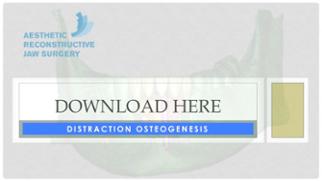

No Comments Yet
Let us know what you think